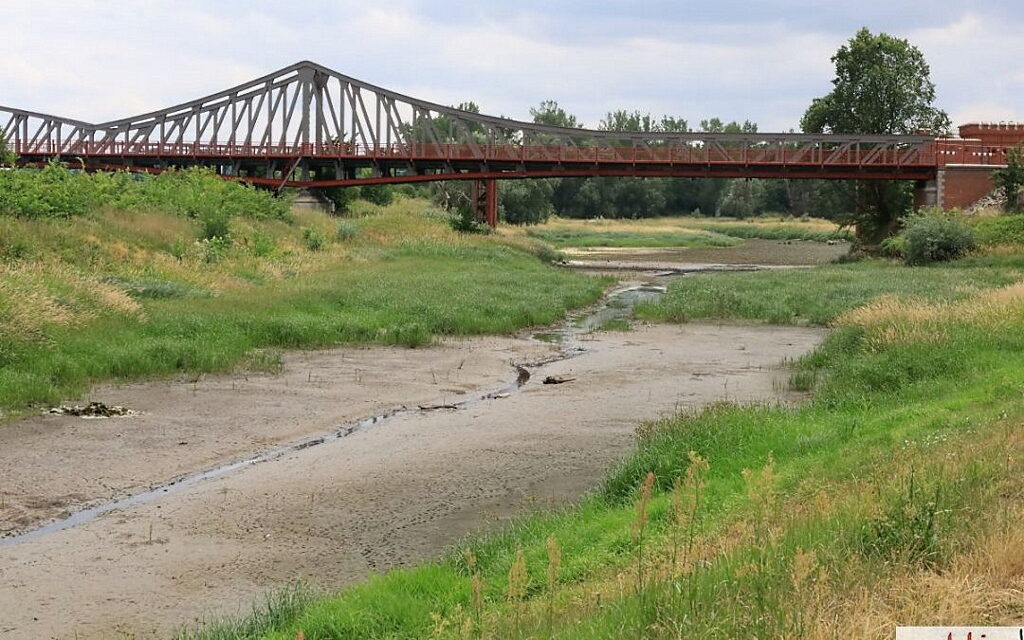Over 170 municipalities (gminy) around the country have introduced restrictions on the use of water, with many Polish rivers and other water supplies running dangerously low.
"The high temperatures of the last few days have shown that drought is a big problem in Poland," wrote PGW WP in a statement on Friday. Its analysis found that 55.64% of the country's land area is at serious risk of drought.
Like many other parts of Europe, Poland has experienced unusually hot weather recently. Last month, the country recorded its joint highest ever June temperature of 38.3°C in the western town of Słubice.
The heatwave has since continued, with last week seeing thermometers hit 35-38°C again in some places, setting a number of local temperature records for July, notes weather service DobraPogoda24.
As a result of recent conditions, water levels have fallen dangerously low in many parts of the country. Parts of the Oder river between Ścinawa and Głogów (pictured at the top of the article) have become unnavigable due to a lack of water, say authorities in the nearby city of Lubin.
On the other side of the country, in the Podkarpacie province, the San river has similarly dried up in places, notes local councillor Mirosław Piela, who shared images of the low water levels on Facebook.
By the end of last week, 173 municipalities around the country had introduced water usage restrictions for residents, reports TVN. More are expected to follow suit. In one, Wola Mała in Podkarpackie, tap water is only being turned on for six hours a day.
A big part of the problem is a lack of water retention systems, Joanna Remiszewska-Michalak, an atmospheric physicist and climate expert, told TVN. That problem has been compounded by many Polish cities concreting over areas that used to contain vegetation, she says.
Another major concern is over the impact of the drought on agriculture, which may exacerbate already rapidly rising inflation as a result of Russia's war in Ukraine. Conditions of agricultural drought have been identified in 15 of Poland's 16 provinces.
"Water deficit for arable crops has increased, causing water scarcity to occur throughout the country," noted the Institute of Soil Science and Plant Cultivation in its last report, which covered the period up to 20 June.
Krzysztof Wojnowski, a farmer with 150 hectares of land in Trzemiętowo, north-central Poland, told state broadcaster TVP that his yields would be 30-40% lower this year as a result of the hot weather. Other local farmers made similar forecasts, reports TVP.
"There is a risk that this year's agricultural production, including cereals, fruit and vegetables, will be lower and, consequently, prices will increase significantly," Jakub Olipra, a senior at Credit Agricole, told Business Insider Polska. These effects will be visible in the second half of this year, added Mariusz Dziwulski of PKO BP bank.
Such developments are part of a longer-term trend towards hotter, drier conditions in Poland, notes the state meteorology and water institute (IMWM-PIB). The average temperature in June last year was 2.5°C higher than the long-term average while precipitation was almost 17% lower.
Daniel Tilles is editor-in-chief of Notes from Poland. He has written on Polish affairs for a wide range of publications, including Foreign Policy, POLITICO Europe, EUobserver and Dziennik Gazeta Prawna.




Reader Comments
If publishers don't go back to the old rule of having your own journalist in the place you write about then they are finished!
By the way, you should make contacts with trusted people in the regions and thus maintain reliable information,
..it was a word to the editorial board:-)